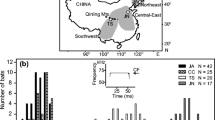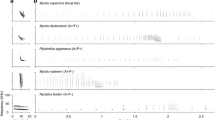Abstract
Mutual recognition is the product of species coexistence, and has direct effects on survival and reproduction of animals. Bats are able to discriminate between sympatric different heterospecifics based on their echolocation calls, which has been shown both in free-flying and captive bats. To date, however, the factors that may determine the behavioral responses of bats to echolocation calls from sympatric heterospecifics have rarely been tested, especially under well-controlled conditions in captive bats. Hence, we aimed at tackling this question by performing playback experiments (habituation–dishabituation) with three horseshoe bat species within the constant-frequency bat guild, which included big-eared horseshoe bats (Rhinolophus macrotis), Blyth’s horseshoe bats (Rhinolophus lepidus), and Chinese horseshoe bats (Rhinolophus sinicus). We studied the behavioral responses of these three species to echolocation calls of conspecifics, to other two species, and to another heterospecifics bat, Stoliczka’s trident bat (Asellisus stoliczkanus), which also belongs to this guild. We found that the three rhinolophid species displayed a series of distinct behaviors to heterospecific echolocation but few to conspecific calls after habituation, suggesting that they may have been able to discriminate sympatric heterospecific echolocation calls from those of conspecifics. Interestingly, the behavioral responses to heterospecific calls were positively correlated with the interspecific overlap index in trophic niche, whereas call design had only a minor effect. This implies that the behavioral responses of these bats to heterospecific echolocation calls may be related to the degree of interspecific food competition.





Similar content being viewed by others
References
Abrams P (1980) Some comments on measuring niche overlap. Ecology 61:44–49
Arlettaz R, Perrin N, Hausser J (1997) Trophic resource partitioning and competition between the two sibling bat species Myotis myotis and Myotis blythii. J Anim Ecol 66:897–911
Arnold SJ, Bennett AF (1988) Behavioural variation in natural populations. V. Morphological correlates of locomotion in the garter snake (Thamnophis radix). Biol J Linn Soc 34:175–190
Balcombe JP, Fenton MB (1988) Eavesdropping by bats: the influence of echolocation call design and foraging strategy. Ethology 79:158–166
Barclay RMR (1982) Interindividual use of echolocation calls: eavesdropping by bats. Behav Ecol Sociobiol 10:271–275
Bee MA (2006) Individual recognition in animal species. In: Naguib M (ed) The encyclopedia of language and linguistics, , 2nd edn. Elsevier, London, pp 617–626
Brunet-Rossinni AK, Wilkinson GS (2009) Methods for age estimation and the study of senescence in bats. In: Kunz TH, Parsons S (eds) Ecological and behavioral methods for the study of bats. The John Hopkins University Press, Baltimore, pp 315–325
Campbell P, Schneider CJ, Zubaid A, Adnan AM, Kunz TH (2007) Morphological and ecological correlates of coexistence in Malaysian fruit bats (Chiroptera: Pteropodidae). J Mammal 88:105–118
Caspers B, Wibbelt G, Voigt CC (2009) Histological examinations of facial glands in Saccopteryx bilineata (Chiroptera, Emballonuridae), and their potential use in territorial marking. Zoomorphology 128:37–43
Cody ML (1969) Convergent characteristics in sympatric bird populations: a possible relation to interspecific territoriality. Condor 71:223–234
Cody ML (1973) Character convergence. Annu Rev Ecol Syst 4:189–211
Coolen I, Bergen YV, Day RL, Laland KN (2003) Species difference in adaptive use of public information in sticklebacks. Proc R Soc Lond B 270:2413–2419
Dorado-Correa AM, Goerlitz HR, Siemers BM (2013) Interspecific acoustic recognition in two European bat communities. Front Physiol 4:192
Fenton MB (2003) Eavesdropping on the echolocation and social calls of bats. Mammal Rev 33:193–204
Findley JS (1993) Bats: a community perspective. Cambridge University Press, Cambridge
Forsman JT, Mönkkönen M, Helle P, Inkeröinen J (1998) Heterospecific attraction and food resources in migrants’ breeding patch selection in northern boreal forests. Oecologia 115:278–286
Gillam EH (2007) Eavesdropping by bats on the feeding buzzes of conspecifics. Can J Zool 85:795–801
Goodale E, Beauchamp G, Magrath RD, Nieh JC, Ruxton GD (2010) Interspecific information transfer influences animal community structure. Trends Ecol Evol 25:354–361
Grether GF, Losin N, Anderson CN, Okamoto K (2009) The role of interspecific interference competition in character displacement and the evolution of competitor recognition. Biol Rev 84:617–635
Griffin DR (1958) Listening in the dark. Yale University Press, New Haven
Griffin DR, Webster FA, Michael CR (1960) The echolocation of flying insects by bats. Anim Behav 8:141–154
Heller KG, von Helversen O (1989) Resource partitioning of sonar frequency bands in rhinolophoid bats. Oecologia 80:178–186
Hurd CR (1996) Interspecific attraction to the mobbing calls of black-capped chickadees (Parus atricapillus). Behav Ecol Sociobiol 38:287–292
Jacobs DS, Barclay RMR (2009) Niche differentiation in two sympatric sibling bat species Scotophilus dinganii and Scotophilus mhlanganii. J Mammal 90:879–887
Jacobs DS, Barclay RMR, Walker MH (2007) The allometry of echolocation call frequencies of insectivorous bats: why do some species deviate from the pattern? Oecologia 152:583–594
Jiang TL, Lu GJ, Sun KP, Luo JH, Feng J (2013) Coexistence of Rhinolophus affinis and Rhinolophus pearsoni revisited. Acta Theriol 58:47–53
Johnstone RA (2001) Eavesdropping and animal conflict. Proc Natl Acad Sci U S A 98:9177–9180
Jones G (1996) Does echolocation constrain the evolution of body size in bats? Symp Zool Soc Lond 69:111–128
Jones G, Siemers BM (2011) The communicative potential of bat echolocation pulses. J Comp Physiol A 197:447–457
Kerth G (2008) Causes and consequences of sociality in bats. Bioscience 58:737–746
Korner P, Whiting MJ, Willem J, Ferguson H (2000) Interspecific aggression in flat lizards suggests poor species recognition. Afr J Herpetol 49:139–146
Kunz TH, Whitaker JO (1983) An evaluation of fecal analysis for determining food habits of insectivorous bats. Can J Zool 61:1317–1321
Lynch A, Baker AJ (1991) Increased vocal discrimination by learning in sympatry in 2 species of chaffinches. Behaviour 116:109–126
Marler P (1957) Specific distinctiveness in the communication signals of birds. Behaviour 11:13–39
Moore RF (1978) Interspecific aggression: toward whom should a mockingbird be aggressive? Behav Ecol Sociobiol 3:173–176
Parsons S, Jones G (2000) Acoustic identification of twelve species of echolocating bat by discriminant function analysis and artificial neural networks. J Exp Biol 203:2641–2656
Qvarnström A, Haavie J, Sæther SA, Eriksson D, Pärt T (2006) Song similarity predicts hybridization in flycatchers. J Evol Biol 19:1202–1209
Racey PA (2009) Reproductive assessment of bats. In: Kunz TH, Parsons S (eds) Ecological and behavioral methods for the study of bats. The John Hopkins University Press, Baltimore, pp 249–264
Ratcliffe JM, ter Hofstede HM (2005) Roosts as information centres: social learning of food preferences in bats. Biol Lett 1:72–74
Russo D, Jones G (2002) Identification of twenty-two bat species (Mammalia: Chiroptera) from Italy by analysis of time-expanded recordings of echolocation calls. J Zool 258:91–103
Ryan MJ (1983) Frequency modulated calls and species recognition in a Neotropical frog. J Comp Physiol 150:217–221
Safi K, Kerth G (2007) Comparative analyses suggest that information transfer promoted sociality in male bats in the temperate zone. Am Nat 170:465–472
Schnitzler H-U, Kalko EKV (2001) Echolocation by insect-eating bats. Bioscience 51:557–569
Schoeman MC, Jacobs DS (2011) The relative influence of competition and prey defences on the trophic structure of animalivorous bat ensembles. Oecologia 166:493–506
Schoener TW (1968) The Anolis lizards of Bimini: resource partitioning in a complex fauna. Ecology 49:704–726
Schoener TW (1970) Nonsynchronous overlap of lizards in patchy habitats. Ecology 51:408–418
Schuchmann M, Siemers BM (2010) Behavioral evidence for community-wide species discrimination from echolocation calls in bats. Am Nat 176:72–82
Siemers BM, Swift SM (2006) Differences in sensory ecology contribute to resource partitioning in the bat Myotis bechsteinii and Myotis nattereri (Chiroptera Vespertilionidae). Behav Ecol Sociobiol 59:373–380
Singaravelan N, Marimuthu G (2008) In situ feeding tactics of short-nosed fruit bat (Cynopterus sphinx) on mango fruits: evidence of extractive foraging in a flying mammal. J Ethol 26:1–7
Stefanski RA, Falls JB (1972) A study of distress calls of song, swamp and white-throated sparrows (Aves: Fringillidae). II. Interspecific responses and properties used in recognition. Can J Zool 50:1513–1525
Übernickel K, Tschapka M, Kalko EKV (2013) Selective eavesdropping behaviour in three Neotropical bat species. Ethology 119:66–76
Voigt-Heucke SL, Taborsky M, Dechmann DKN (2010) A dual function of echolocation: bats use echolocation calls to identify familiar and unfamiliar individuals. Anim Behav 80:59–67
Whitaker JO (1988) Food habits of insectivorous bats. In: Kunz TH (ed) Ecological and behavioral methods for the study of bats. Smithsonian Institution Press, Washington, pp 171–189
Yovel Y, Melcon ML, Franz MO, Denzinger A, Schnitzler H-U (2009) The voice of bats: how greater mouse-eared bats recognize individuals based on their echolocation calls. PLoS Comput Biol 5:e1000400
Acknowledgments
The work was funded by the National Natural Science Foundation of China (grant no. 31030011, 31270414, 31100280, 31100281). We would like to thank Mr. Fushun Yang and his family, Lifen Xie, and Xiong Guo for their help in the field, and Jinhong Luo for his invaluable suggestions and comments on the manuscript. We also thank Songtao Yang for his help in making the experimental box and Lei Wang for his help in diet analysis of bats.
Ethical standards
All experiments were approved by the Department of Wildlife Administration in Shuanghe Township, Yunnan province, China.
Author information
Authors and Affiliations
Corresponding authors
Additional information
Communicated by C. Voigt
Rights and permissions
About this article
Cite this article
Li, Y., Wang, J., Metzner, W. et al. Behavioral responses to echolocation calls from sympatric heterospecific bats: implications for interspecific competition. Behav Ecol Sociobiol 68, 657–667 (2014). https://doi.org/10.1007/s00265-013-1680-9
Received:
Revised:
Accepted:
Published:
Issue Date:
DOI: https://doi.org/10.1007/s00265-013-1680-9




